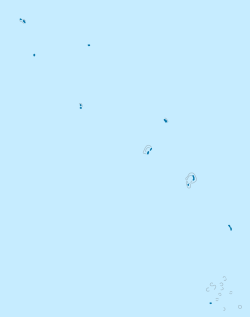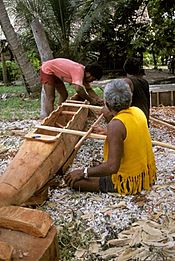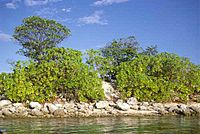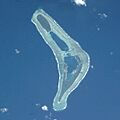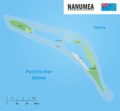Nanumea facts for kids
Quick facts for kids
Nanumea
|
|
|---|---|
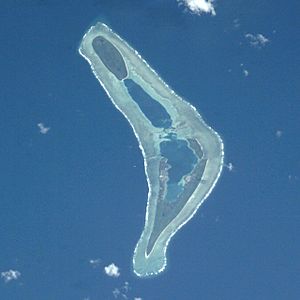
Nanumea atoll from space
|
|
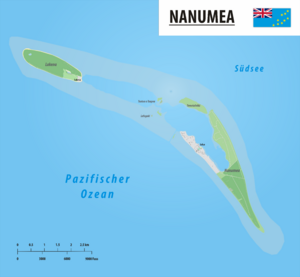
Map of the atoll
|
|
| Country | Tuvalu |
| Area | |
| • Total | 3.9 km2 (1.5 sq mi) |
| Population
(2017)
|
|
| • Total | 512 |
| • Density | 131.3/km2 (340/sq mi) |
| ISO 3166 code | ISO416TV-NMA |
Nanumea is the most northwestern atoll in Tuvalu, a country made of nine coral atolls and islands. Tuvalu is located in the Pacific Ocean, just south of the equator. Nanumea is about 4 square kilometers in size and had a population of 512 people in 2017.
Contents
Exploring Nanumea's Geography
Nanumea is a classic atoll, which means it's a ring of low islets (small islands) sitting on a coral reef shelf. This reef surrounds a central lagoon. The atoll is about 12 kilometers long and 2.5 kilometers wide. Its total dry land area is about 3.9 square kilometers.
Islands and Villages of Nanumea
The two largest islets are Nanumea and Lakena. They make up 90% of the atoll's dry land. The main villages are Haumaefa and Lolua, each with 187 people in 2012. The junior school is called Kaumaile Primary School. There are also smaller homes on Motu Foliki and Lakena islet. Besides Nanumea and Lakena, there are three tiny islets: Motu Foliki, Lafogaki, and Te Afua-a-Taepoa.
Nature and Conservation on Nanumea
Nanumea has two mangrove forests, one south of Nanumea islet and another on Lakena. Since the early 1990s, using nets and spears to fish has been banned in the lagoon. In 2006, the Nanumea Conservation Area was created. This area covers about 2 square kilometers of the central lagoon. It protects about 10% of the atoll's reef and includes marine habitats and two islets.
Farming and Trees on Nanumea
The islanders grow a plant called pulaka (also known as swamp taro) in large pits on Lakena. They do this to keep the main island of Nanumea free of mosquitoes. Pulaka grows in composted soil below the water level.
In 2011, a small worm called the kou leafworm caused a lot of damage on Nanumea. It stripped the leaves from the Kanava trees. These trees are very important because they protect the coast, block wind, provide shade, and are home to sea birds. Their flowers are also highly valued by the local people.
Impact of Climate Change on Nanumea
In March 2015, Nanumea was hit by Cyclone Pam. This storm caused damage to homes, crops, and other structures due to strong storm surges. In 2016, the Tuvalu National Council for Women worked with the Green Climate Fund. They helped women from Nanumea and Nanumaga join discussions about the climate crisis. One important issue they raised was how natural disasters create more work for women in social care.
Language and Culture of Nanumea
The people of Nanumea are Polynesians. Their dialect of the Tuvaluan language is similar to other West Polynesian languages like Tongan, Tokelauan, and Samoan. While the eight communities in Tuvalu have different accents and some unique words, most Tuvaluan dialects are easy for speakers to understand. The only exception is the language of Nui atoll, where people speak a dialect of the Gilbertese language. English is also spoken, especially in Tuvalu's capital, Funafuti. It is one of the official languages of the government.
History of Nanumea Atoll
The traditional stories of Nanumea tell of its settlement by a warrior named Tefolaha. Some stories say he came from Tonga, others from Samoa. Tefolaha found the island inhabited by two women, Pai and Vau, who were believed to have created the island from baskets of sand. Tefolaha tricked them and won the island, and Pai and Vau left. Today, Tefolaha's children are the ancestors of the leading families and the seven main family lines of Nanumea. The smaller islets, Motu Foliki, Lafogaki, and Te Afua-a-Taepoa, are said to have formed when sand spilled from Pai and Vau's baskets as they left.
The Legendary Kaumaile Spear
The legendary spear called Kaumaile came with Tefolaha to Nanumea. He used this 1.8-meter-long weapon in battles on Samoa and Tonga. When Tefolaha died, the spear was passed down through 23 generations of his family. Scientists have tested the wood from the spear and found it is about 880 years old, dating back to AD 1070. The wood is from a tree called Casuarina equisetifolia.
Early European Sightings and Traders
The first European to see Nanumea was Spanish naval officer Francisco Mourelle de la Rúa on May 5, 1781. He named it San Augustin. In 1809, Captain Patterson also saw Nanumea while sailing from Australia to China.
From 1879 to 1881, Alfred Restieaux was a trader living on Nanumea. Other traders in the 1800s included Tom Day and Jack Buckland. The population of Nanumea during this time was estimated to be between 500 and 650 people. The Nanumea Post Office opened around 1919.
World War II on Nanumea
During World War II, American forces built Nanumea Airfield on the atoll. The local people moved to live on Lakena during this time. A ship called USS LST-203 was deliberately grounded on the reef in October 1943 to unload equipment. Its rusty hull can still be seen on the reef today. American Naval Construction Battalions, known as Seabees, blasted a passage through the reef with help from local divers. This "American Passage" made it easier to access Nanumea. After the war, the airfield was taken apart, and the land was given back to its owners. However, because the coral base was compacted to make the runway, the land is now not good for growing coconuts. Today, small boats use the "American Passage" to bring passengers and cargo from larger inter-island ships to a small wharf inside the lagoon.
How Nanumea is Governed
Nanumea's local government includes a council of chiefs called the Falekaupule. This council represents the seven main family lines that trace back to the founder, Tefolaha, or other early settlers. There is also an elected high chief called the Pulefenua. The island also elects two people to represent them in the national parliament in the capital, Funafuti.
Many Nanumeans also live outside the atoll, especially in Funafuti, New Zealand (like Auckland and Wellington), Australia, and other Pacific places. These communities are well-organized with their own elected leaders, and they stay in close contact with Nanumea.
2019 General Election Results for Nanumea
In the 2019 Tuvaluan general election, Maatia Toafa and Satini Manuella were not re-elected. Ampelosa Manoa Tehulu and Timi Melei were chosen to represent Nanumea in parliament.
Nanumean Identity and Celebrations
Nanumeans show their unique identity and pride in many ways. This includes their special way of speaking Tuvaluan and their celebrations. One important celebration is Po o Tefolaha, which is part of a long holiday called "Big Days" (Po Lahi). These celebrations cover Christmas, New Year, and several weeks after. During Po Lahi, people gather for feasts in the island's community hall, called the aahiga or maneapa. They also play a competitive ball game called Ano, with the two village teams, Haumaefa and Lolua, playing against each other. On January 8th each year, Po o Tefolaha (Tefolaha's Day) celebrates the island's conversion to Christianity over a century ago. Po Lahi is celebrated on Nanumea and by Nanumean communities living overseas, including those in Funafuti, Fiji, Auckland, Wellington, Tarawa, and Australia.
The "Kaumaile" fighting spear is a well-known symbol of Nanumean identity and unity. It is said that the island's founder, Tefolaha, brought it with him. Kaumaile was used to defeat invaders, most famously by a hero named Lapi who defeated a giant named Tuulaapoupou. Recent tests show that the Kaumaile spear is over 800 years old.
Important People from Nanumea
- Lady Naama Maheu Latasi (died 2012) was the first woman elected to the Parliament of Tuvalu. She was elected from the Nanumea area.
- Maatia Toafa (born 1954) was the Prime Minister of Tuvalu from 2004 to 2006. He continues to represent Nanumea in the Parliament of Tuvalu. He also served as the Minister of Finance and Economic Development from 2013 to 2019.
- Willy Telavi (born 1954) was first elected to parliament in 2006. He became the Home Affairs Minister and later the Prime Minister of Tuvalu in 2010. His term as prime minister ended in 2013, and he resigned from Parliament in 2014.
Images for kids
See also
 In Spanish: Nanumea para niños
In Spanish: Nanumea para niños


